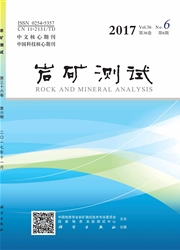

 中文摘要:
中文摘要:
正构烷烃是自然界中广泛分布的生物标志化合物,其链长及主峰碳常被用来指示古气候和古植被变化。我们测定了贡嘎山、太白山和黄土高原地区65个植物样品叶蜡正构烷烃的分子分布特征,并对1232个木本和草本植物(包括本实验的65个样品)的正构烷烃比值进行统计。研究表明:木本和草本植物正构烷烃中C29和C31含量基本均较高,其相对丰度变化很大,其中木本植物主峰碳为C27或C29的占61.9%,草本植物主峰碳为C31的占65.2%。三元相图分析也表明,木本和草本植物C27、C29和C31的相对丰度重叠部分较大,而以C27、C29和C31为标准对木本和草本植物进行判别分析的准确度为69.5%。研究结果表明C27、C29和C31主峰碳丰度不能作为区分木本和草本植物的有效指标。同样,利用C31/C29或C31/C2,也不能够区分木本和草本植物。我们发现以C33/(C33+C29)=0.30为标准对木本和草本植物进行判别分析的准确度为81.5%,而以C33/(C33+C27)=0.20为标准对灌木和草本植物进行判别分析的准确度为85.7%,表明某些正构烷烃比值可能具有区分木本和草本植物的潜力,但结合1232个木本和草本植物数据统计发现,正构烷烃比值不能有效区分木本和草本植物。因此,应谨慎利用正构烷烃主峰碳及比值进行植被恢复,这可能为古气候和古植被重建提供必要的参考。
 英文摘要:
英文摘要:
The biomarkers n-alkanes are ubiquitous in nature environment. Its chain length and dominant carbon are commonly used to indicate the changes of paleoclirnate and paleovegetation. Here we analyzed the distribution of plant leaf wax n-alkanes in 65 plant samples from the Gongga Mountain, Taibai Mountain and Chinese Loess Plateau in China and we also combined 1232 observations of grasses and woody plants, including the new data here, to examine the chain-length ratios of n-alkanes of different vegetation types. We found that: n-alkane distributions for grasses and woody plants showed high variabilities and only 61.9% woody plants were dominated by C27 or C29, while 65.2% grasses were dominated by C31. The accuracy was about 69.5% when C27, C29 and C31 were used as criterions to distinguish woody plants and grasses, and the large overlaps of ternary diagrams based on chain-length abundances also showed that it should be prudent to use n-alkane distributions as quantitative indicators. Similarly, C31/C29 or C31/C27 can't distingl.lish woody plants and grasses, either. Moreover, our results demonstrated that when C33/(C33+C29)=0.30 or C3/(C33+C27)=0.20were taken as criterions to differentiate woody plants or shrubs from grasses, the accuracies were 81.5% and 85.7%, respectively, indicating that some chain-length ratios ofn-alkanes could be used as effective indicators to some extent. However, results showed that the chain-length ratios of n-alkanes can't distinguish woody plants/shrubs from grasses effectively according to the statistics of 1232 observations of grasses and woody plants. Indeed, variations of n-alkane distributions may be affected not only by vegetation types, but also by local environmental conditions. Therefore, leaf wax n-alkane distributions of dominant carbons and chain- length ratios should not be regarded as robust indicators for paleoclimate and paleovegetation reconstruction.
 同期刊论文项目
同期刊论文项目
 同项目期刊论文
同项目期刊论文
 期刊信息
期刊信息
